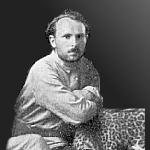
 |
||
| Auld | ||
| Baghy | ||
| Boulton | ||
| Kalocsay | ||
| Mikhalsky | ||
|
*
biography
|
||
| Szathmari | ||
| Home | ||
| Esperanta versio | ||
| DHTML version for version 4 browsers | ||
|
The outbreak of the October Revolution and the post-war growth of proletarian revolutionary movements in almost every economically developed nation, enthused many poets who attempted to express that new sense of optimism about the coming world order in their work. Among them was a group of Esperanto-language writers within the former Tsarist empire who came to be known as the Soviet and Proletarian School. The list of names includes Nekrasov, Grigorov, Khrima, Matkowski, Burger and Mikhalsky. The greatest of these was undoubtedly the latter - the Russian teacher Yevgeny Mikhalsky (1897 - 1937), who learned Esperanto in 1911 and in 1917 founded a literary review in Saratov: Libera Torento (Free Torrent). Mikhalsky's original poems appeared in:
L'Unua Ondo immediately showed an extraordinary technical and linguistic maturity. From the opening stanza the firebrand was revealed, ardent and impulsive. Throughout his verse, he underscored the development of his inspiration, through bold changes in rhythm. Prologo was considered by most critics to be his chef d'oeuvre. However it was largely ignored for some time. Work on Fajro kuracas was hampered by the political situation within the Soviet Union in the thirties. In spite of this, in his last published collection, he turned to themes of class warfare, extending an already vast gamut of themes. Unfortunately, several important original manuscripts were lost. For example, only a few fragments remain of the poem Reforgho de l'Homo (The Reforging of Man), which consisted of 5000 verses and was finished around 1935. In 1931, Mikhalsky founded IAREV (The International Association of Revolutionary Esperanto Writers), together with the German writer Ludwig Renn. The journal of IAREV - La Nova Etapo (The New Stage), quickly began to reflect the regression on several fronts in the Esperanto movement within the Soviet Union. In 1932 La Nova Etapo was still full of interesting contributions about the relationship between Marxism and international language. In 1933 there appeared only one drab issue which consisted almost exclusively of translations of articles on the current five-year plan. There has never been official confirmation that Esperanto was suppressed in the Soviet Union. Nevertheless, it is clear that the sense of hopelessness that pervaded the movement towards the middle of the decade, turned to terror in the years 1937-38. Many Esperanto speakers fell victim to the Stalinist purges. Ulrich Lins in his detailed study of the persecution of the adherents of the International Language movement - La Danghera Lingvo (The Dangerous Language), writes: "We know without further details... that Mikhalsky... died tragically in 1937." |
|||
| TOP | |||